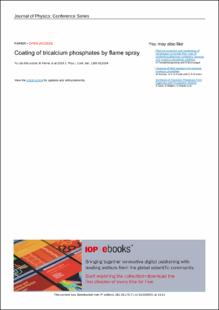Coating of tricalcium phosphates by flame spray
Artículo de revista
2019-11-29
Journal of Physics: Conference Series
Inglaterra
The metal alloys used for prostheses with high mechanical requirements are bioinerts, it means they have low integration with bone tissue, therefore, bioactive coatings are used in order to improve this integration. Hydroxyapatite is one of the most studied materials for this application with good results, however, sometimes there are problems due to wear or tear of the coating leading prostheses loss. Tricalcium phosphate, Ca3(PO4)2, in its different phases shows osteoconductivity and higher solubility than hydroxyapatite, however, few studies have been carried out to determine its behavior as a coating for this type of applications. In this work, a study of the behavior of tricalcium phosphate as a coating on Ti6Al4V substrates obtained by flame spraying was carried out. As raw material were used tricalcium phosphate powders obtained by precipitation from calcium nitrate and ammonium phosphate dihydrogen solution, and subsequent calcination at 1,100°C. The Ca/P molar ratio obtained is 1.48 and the only present crystalline phase is beta -tricalcium phosphate. The coatings obtained have alpha tricalcium phosphate as only crystalline phase, they have compact morphology with low porosity and good wettability with the substrate, which is an index of good adhesion and good mechanical behavior. The transformation from beta- to alpha- tricalcium phosphate is product of the high temperatures used in the process, which are higher than 1,125°C where this transformation occurs.
Descripción:
Coating of tricalcium phosphates by flame spray.pdf
Título: Coating of tricalcium phosphates by flame spray.pdf
Tamaño: 1.098Mb
 PDF
PDF
 LEER EN FLIP
LEER EN FLIP
Título: Coating of tricalcium phosphates by flame spray.pdf
Tamaño: 1.098Mb
 PDF
PDF
 LEER EN FLIP
LEER EN FLIP















